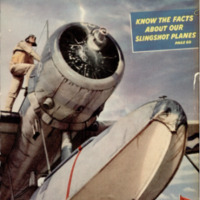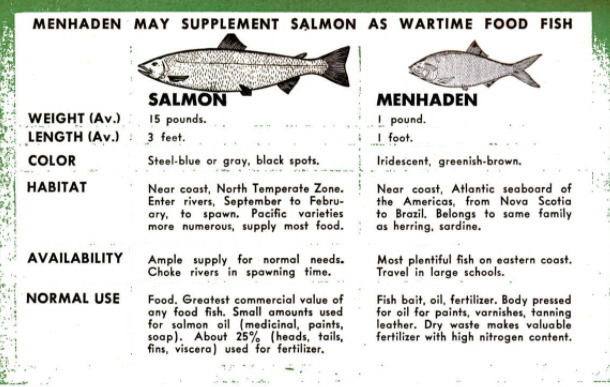-
Title (Dublin Core)
-
Food from the wild
-
Article Title and/or Image Caption (Dublin Core)
-
Title: Food from the wild
-
Subtitle: Science ransacks nature to meet wartime food demands
-
extracted text (Extract Text)
-
MEET a new kind of fishermen. Using
neither hooks, seines, oilskins, nor
rubber boots, they've caught a whop-
per which promises to change our diet.
President Roosevelt, himself no mean
wielder of rod and reel, arranged their fish-
ing party. It was with test tube and micro-
scope—and out of all the fish in the ocean
they found just the right one to meet a war
shortage. Their catch is the menhaden. If
you've never heard of it, you soon will. For
this prolific fish is the choice to pinch-hit
on the home front for the salmon going to
our overseas troops and our allies. It's
known off Jersey shores as the mossbunker,
heretofore regarded as a scrap fish.
That curious fishing expedition is but
one of the wartime activities of scientists
of the United States Fish and Wildlife Serv-
ice at the 3,000-acre Patuxent Wildlife
Refuge in eastern Maryland, You find them
carrying on, for the first time anywhere,
successful experiments in polygamist quail
breeding to speed propagation; they are giv-
ing the red fox and other prized fur-bearing
animals a new lease on life by their work
in disease prevention; they have figuratively
counted the noses of this nation’s big and
small game animals to the benefit of hunters
and depleted beef stocks; they have kept
a constant check on the flyways to protect
ducks, geese, and upland birds; they have
found new food for these birds and animals;
and, by a queer turn, they have brewed
poisons to take the place of poisons cut off
by the war that were our only means of
controlling the propagation of harmful and
destructive birds and animals.
Poison brewing became urgent soon after
the first torpedo of World War II exploded. |
Red squill, one of the most effective anti-
rodent poisons, came from the Mediter-
ranean area. Nux vomica, another death |
dealer, came from territory now overrun by
the Japanese. Thallium, perhaps the most |
deadly of all, came from Germany. Even
before the war, when these poisons were
easily obtained, the annual damage in this
country from rats alone amounted to $189,-
000,000. So the need for substitutes was |
great. |
The Patuxent chemists tackled the job
with a pharmacological and chemical ap-
proach that revealed the poison principle of
the imported drugs. Then they attempted
to match it. Into their laboratory came hun-
dreds of native plants to be tested (or poison
content, Into thelr test tubes went scores
of chemical combinations Lo create syn-
thetic poisons. It wasn't long before they
had prepared 150 specimens. These were
rushed to the Fish and Wildlife Service
Iuboratories at Denver for actual tests in
killing. Findings showed the Patuxent chem-
ists had uncovered 10 American plants with
poisoning potentialities equaling those of
red squill and nux vomica. These plants, ex-
isting in great abundance, are Indian hemp,
calfkill, stagger grass, larkspur, American
hellebore, death camass, monkshood, Jim-
son weed, water hemlock, and poison hem.
lock, Poisons from these plants are ob-
tained by a simple process of distillation
and concentration.
When the war began making heavy in-
roads into our beef supply, the Government
again turned to Patuxent.” Experts there got
together data from all parts of the country,
announced there were 6,000,000 big-game
animals of which 600,000 could be taken
annually without endangering any of the
species. Thi represents 60,000,000 pounds
of meat & year for our dinner tables. Added
to this, the service estimated a possible
yearly Kill of 10,000,000 ducks and geese,
20,000,000 rabbits, 15,000,000 upland birds,
and 4,000,000 other small game.
Maintenance of this great potential food
supply was the tough problem. Present was
the danger of disease, shortages in wildlife
foods, and the elimination of certain species
by hunters. Research in disease prevention
and nutrition had been carried on by the
service for years, but under peacetime con-
ditions. New ways and means had to be
found. War made it virtually impossible to ob-
tain expensive test animals such as red fox and
mink. So the scientists turned to other sources,
and began breeding more ferrets, white mice,
and guinea pigs. They put hen eggs to an
amazing use. Kggs were placed in an incu-
bator until the embryo was well formed. In-
oculated with a virus or disease-producing bac-
teria, the embryo served as a living culture
medium within its own sterile package. It
took the place of living test animals in find-
ing protective and curative agents for dis-
eases of wildlife. Results of experiments
were passed on quickly to wildlife refuges,
naturalists, zoologists, and the nation’s fur
farmers.
Three thousand bobwhite quail were
raised at Patuxent last season, The main
objectives were to increase propagation and
to develop new quail foods that could be
supplied under war conditions. Both were
achieved. Quail are inveterate monoga-
mists. They were introduced to polygamist
breeding. Male birds were placed in pens
with three, six, and 12 females. The fer-
tility of the eggs fell off as much as 50 per-
cent as compared with normal mating, but
the increase In egg production spelled suc-
cess. The radical change in the quail's home
lie caused some disturbing incidents at first,
with an occasional death from fights caused
by jealousy. As the season wore on, how-
ever, most of the breeders accepted the new
setup.
The Patuxent scientists meticulously
charted a complete cycle in quail life—from
gE to chick to breeder to egg—keeping in-
dividual records of all birds raised. This
was important in developing the new diet
in which soybean meal, corn meal, and other
nourishing foods were used in place of ribo-
flavin concentrate, sardine fish meal, and
other things needed for the war.
Another task was the development of
natural foods for migratory fowl, About
half a mile from the main Patuxent labora-
tory is a series of 24 ponds, each 50 by 30
feet. There experts studied and experi
mented with aquatic and marsh plants.
Their findings may prevent the starvation
of great numbers of ducks and geese in
crowded breeding grounds.
With a million duck hunters in this coun-
try, it is imperative to have regulations
that will maintain the supply in sufficient
quantity to permit the annual forays to
‘marsh, lake shore, and river bank—in war
as well as in peace. These regulations are
not the vagrant thoughts of some official.
They are devised each year after long and
careful study by the Fish and Wildlife ex-
perts. The Patuxent Refuge is the clearing
house for all information used to establish
hunting and fishing laws. During migrating,
breeding, and wintering seasons, a constant
flow of reports comes from field personnel
and co-operating outdoorsmen.
The service's bird-banding system is a
source of information of the highest ac-
curacy. Of nearly 4,000,000 birds marked
with the numbered aluminum bands, 250,000
have been subsequently reported. This has
supplied a file of precise details on sex, age,
and migrating habits. Some ducks have
carried bands for 15 years, though the aver-
age bird is reported within two or three
years of banding. From the moment of
banding all information on the bird is tabu-
lated. Cards at the Patuxent refuge are
kept with the same care and, indeed, by the
same method as the Federal Bureau of In-
vestigation’s fingerprint system. The cards
are passed through a perforating machine
which notes number and other data. Later
it takes only a few seconds to locate the
cards by passing the file through a shuffling
machine. Wartime shortage of aluminum
has caused officials to cut down on banding,
but they are maintaining the status quo of
the system as far as possible.
It was on July 21, 1942, that President
Roosevelt called on scientists of the Fish
and Wildlife Service to find a substitute
for salmon. What he hoped for was a fish-
ing expedition as successful as the one that
brought tuna—then unknown as a food fish
—to our dinner tables in the last war. What
he got was the menhaden, which not only
may surpass tuna as a tasty dish but vies
with salmon in food value and abundance.
Though its name is of American Indian
origin and its abundance has been known
for years, the menhaden has
never been sought for as food.
The millions of pounds taken
each year along the Atlantic
seaboard have been pressed
for oil and used to enrich the
soil. Much smaller than
either tuna or salmon —it
ranges from 12 to 16 inches
in length when mature—the
menhaden travels in great
silvery schools and is easily
captured with large nets.
In their survey, the Patuxent scientists
tested hundreds of American fish for edi-
bility and food value. For their purpose,
fish were hauled in off the rock-bound
coasts of Maine, the shores of Jersey, and
the palm-fringed Florida keys. Big fish and
little fish, deep-sea fish and estuary fish—
all were studied. Fish to be tested were first
canned at the Federal Fisheries Laboratories
at College Park, Md. At Patuxent, the
scientists removed the fish from the cans
and placed them in digestive racks—simply
glass retorts—which released the nitrogen
content as ammonium sulphate. The ammo-
nium sulphate was then placed in a Kjeldahl
distilling rack where the
‘ammonium was passed off as |
anitrate. By neutializing and |
measuring this nitrate, the |
chemists were able to calcu |
late the amount of protein in
each type of fish. They also
found that alewives, hake, |
and sea herring have a high |
food value and make very |
tasty dishes. So these, too, |
may soon find their way into |
our kitchens, —JACK O'BRINE,
-
Contributor (Dublin Core)
-
William W. Morris (Photographer)
-
Language (Dublin Core)
-
eng
-
Date Issued (Dublin Core)
-
1943-05
-
pages (Bibliographic Ontology)
-
120-124
-
Rights (Dublin Core)
-
Public Domain (Google Digitized)
-
Archived by (Dublin Core)
-
Matteo Ridolfi
-
Marco Bortolami (editor)
 Popular Science Monthly, v. 142, n. 5, 1943
Popular Science Monthly, v. 142, n. 5, 1943




